service indicator SKODA OCTAVIA TOUR 2009 1.G / (1U) Owner's Manual
[x] Cancel search | Manufacturer: SKODA, Model Year: 2009, Model line: OCTAVIA TOUR, Model: SKODA OCTAVIA TOUR 2009 1.G / (1U)Pages: 224, PDF Size: 13.53 MB
Page 4 of 224
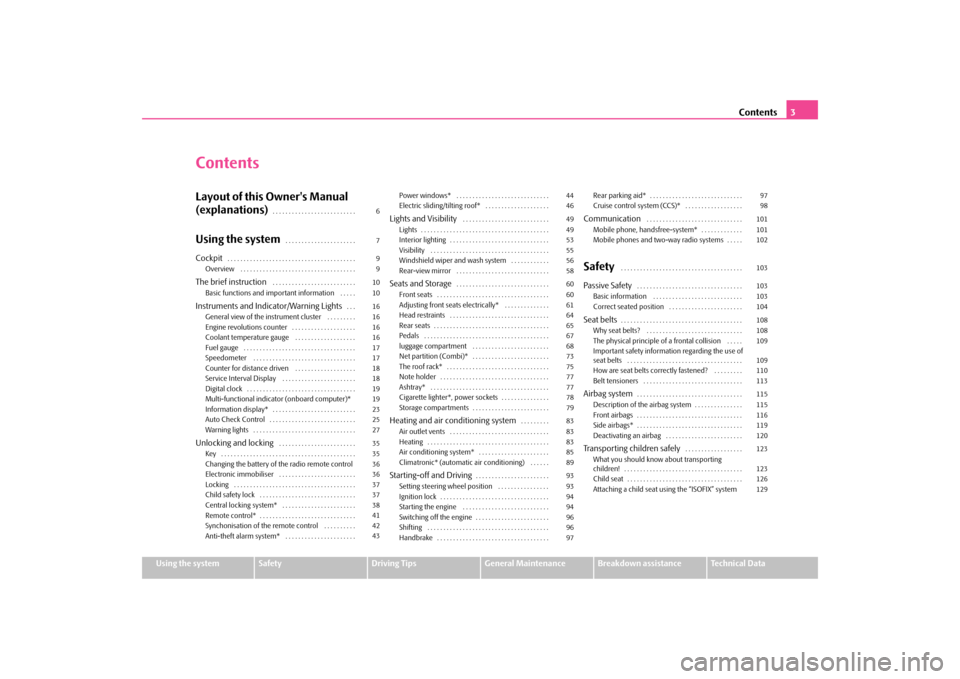
Contents
3
Using the system
Safety
Driving Tips
General Maintenance
Breakdown assistance
Technical Data
ContentsLayout of this Owner's Manual (explanations)
. . . . . . . . . . . . . . . . . . . . . . . . . .
Using the system
. . . . . . . . . . . . . . . . . . . . . .
Cockpit
. . . . . . . . . . . . . . . . . . . . . . . . . . . . . . . . . . . . . . . .
Overview . . . . . . . . . . . . . . . . . . . . . . . . . . . . . . . . . . . . The brief instruction
. . . . . . . . . . . . . . . . . . . . . . . . . .
Basic functions and important information . . . . . Instruments and Indicator/Warning Lights
. . .
General view of the instrument cluster . . . . . . . . . Engine revolutions counter . . . . . . . . . . . . . . . . . . . . Coolant temperature gauge . . . . . . . . . . . . . . . . . . . Fuel gauge . . . . . . . . . . . . . . . . . . . . . . . . . . . . . . . . . . . Speedometer . . . . . . . . . . . . . . . . . . . . . . . . . . . . . . . . Counter for distance driven . . . . . . . . . . . . . . . . . . . Service Interval Display . . . . . . . . . . . . . . . . . . . . . . . Digital clock . . . . . . . . . . . . . . . . . . . . . . . . . . . . . . . . . . Multi-functional indicator
(onboard computer)*
Information display* . . . . . . . . . . . . . . . . . . . . . . . . . . Auto Check Control . . . . . . . . . . . . . . . . . . . . . . . . . . . Warning lights . . . . . . . . . . . . . . . . . . . . . . . . . . . . . . . . Unlocking and locking
. . . . . . . . . . . . . . . . . . . . . . . .
Key . . . . . . . . . . . . . . . . . . . . . . . . . . . . . . . . . . . . . . . . . . Changing the battery of the radio remote controlElectronic immobiliser . . . . . . . . . . . . . . . . . . . . . . . . Locking . . . . . . . . . . . . . . . . . . . . . . . . . . . . . . . . . . . . . . Child safety lock . . . . . . . . . . . . . . . . . . . . . . . . . . . . . . Central locking system* . . . . . . . . . . . . . . . . . . . . . . . Remote control* . . . . . . . . . . . . . . . . . . . . . . . . . . . . . . Synchonisation of the remote control . . . . . . . . . . Anti-theft alarm system* . . . . . . . . . . . . . . . . . . . . . .
Power windows* . . . . . . . . . . . . . . . . . . . . . . . . . . . . . Electric sliding/tilting roof* . . . . . . . . . . . . . . . . . . . . Lights and Visibility
. . . . . . . . . . . . . . . . . . . . . . . . . . .
Lights . . . . . . . . . . . . . . . . . . . . . . . . . . . . . . . . . . . . . . . . Interior lighting . . . . . . . . . . . . . . . . . . . . . . . . . . . . . . . Visibility . . . . . . . . . . . . . . . . . . . . . . . . . . . . . . . . . . . . . Windshield wiper and wash system . . . . . . . . . . . . Rear-view mirror . . . . . . . . . . . . . . . . . . . . . . . . . . . . . Seats and Storage
. . . . . . . . . . . . . . . . . . . . . . . . . . . . .
Front seats . . . . . . . . . . . . . . . . . . . . . . . . . . . . . . . . . . . Adjusting front seats electrically* . . . . . . . . . . . . . . Head restraints . . . . . . . . . . . . . . . . . . . . . . . . . . . . . . . Rear seats . . . . . . . . . . . . . . . . . . . . . . . . . . . . . . . . . . . . Pedals . . . . . . . . . . . . . . . . . . . . . . . . . . . . . . . . . . . . . . . luggage compartment . . . . . . . . . . . . . . . . . . . . . . . . Net partition (Combi)* . . . . . . . . . . . . . . . . . . . . . . . . The roof rack* . . . . . . . . . . . . . . . . . . . . . . . . . . . . . . . . Note holder . . . . . . . . . . . . . . . . . . . . . . . . . . . . . . . . . . Ashtray* . . . . . . . . . . . . . . . . . . . . . . . . . . . . . . . . . . . . . Cigarette lighter*, power sockets . . . . . . . . . . . . . . . Storage compartments . . . . . . . . . . . . . . . . . . . . . . . . Heating and air conditioning system
. . . . . . . . .
Air outlet vents . . . . . . . . . . . . . . . . . . . . . . . . . . . . . . . Heating . . . . . . . . . . . . . . . . . . . . . . . . . . . . . . . . . . . . . . Air conditioning system* . . . . . . . . . . . . . . . . . . . . . . Climatronic* (automatic air conditioning) . . . . . . Starting-off and Driving
. . . . . . . . . . . . . . . . . . . . . . .
Setting steering wheel position . . . . . . . . . . . . . . . . Ignition lock . . . . . . . . . . . . . . . . . . . . . . . . . . . . . . . . . . Starting the engine . . . . . . . . . . . . . . . . . . . . . . . . . . . Switching off the engine . . . . . . . . . . . . . . . . . . . . . . . Shifting . . . . . . . . . . . . . . . . . . . . . . . . . . . . . . . . . . . . . . Handbrake . . . . . . . . . . . . . . . . . . . . . . . . . . . . . . . . . . .
Rear parking aid* . . . . . . . . . . . . . . . . . . . . . . . . . . . . . Cruise control system (CCS)* . . . . . . . . . . . . . . . . . . Communication
. . . . . . . . . . . . . . . . . . . . . . . . . . . . . .
Mobile phone, handsfree-system* . . . . . . . . . . . . . Mobile phones and two-way radio systems . . . . . Safety
. . . . . . . . . . . . . . . . . . . . . . . . . . . . . . . . . . . . . .
Passive Safety
. . . . . . . . . . . . . . . . . . . . . . . . . . . . . . . . .
Basic information . . . . . . . . . . . . . . . . . . . . . . . . . . . . Correct seated position . . . . . . . . . . . . . . . . . . . . . . . Seat belts
. . . . . . . . . . . . . . . . . . . . . . . . . . . . . . . . . . . . . .
Why seat belts? . . . . . . . . . . . . . . . . . . . . . . . . . . . . . . The physical principle of a frontal collision . . . . . Important safety information regarding the use of seat belts . . . . . . . . . . . . . . . . . . . . . . . . . . . . . . . . . . . . How are seat belts correctly fastened? . . . . . . . . . Belt tensioners . . . . . . . . . . . . . . . . . . . . . . . . . . . . . . . Airbag system
. . . . . . . . . . . . . . . . . . . . . . . . . . . . . . . . .
Description of the airbag system . . . . . . . . . . . . . . . Front airbags . . . . . . . . . . . . . . . . . . . . . . . . . . . . . . . . . Side airbags* . . . . . . . . . . . . . . . . . . . . . . . . . . . . . . . . . Deactivating an airbag . . . . . . . . . . . . . . . . . . . . . . . . Transporting children safely
. . . . . . . . . . . . . . . . . .
What you should know about transporting children! . . . . . . . . . . . . . . . . . . . . . . . . . . . . . . . . . . . . . Child seat . . . . . . . . . . . . . . . . . . . . . . . . . . . . . . . . . . . . Attaching a child seat using the “ISOFIX” system
6 7 9 9 10 10 16 16 1616171718181919232527 35 35 3636373738414243
44 46 49 49 53555658 60 60 6164656768737577777879 83 83 838589 93 93 9494969697
97 98 101 101 102 103 103 103 104 108 108 109 109 110113 115 115 116 119 120 123 123 126129
s2g8.b.book Page 3 Tuesday, April 7, 2009 8:53 AM
Page 17 of 224
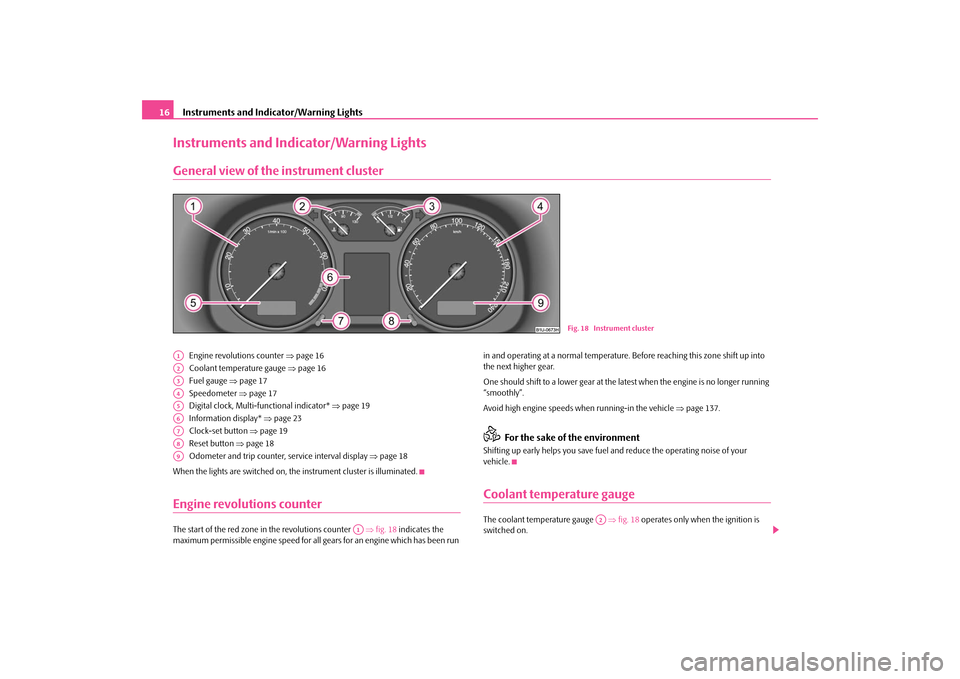
Instruments and Indicator/Warning Lights
16
Instruments and Indicator/Warning LightsGeneral view of the instrument cluster
Engine revolutions counter
⇒page 16
Coolant temperature gauge
⇒page 16
Fuel gauge
⇒page 17
Speedometer
⇒page 17
Digital clock, Multi-functional indicator*
⇒page 19
Information display*
⇒page 23
Clock-set button
⇒page 19
Reset button
⇒page 18
Odometer and trip counter, service interval display
⇒page 18
When the lights are switched on, the instrument cluster is illuminated.Engine revolutions counterThe start of the red zone in the revolutions counter
⇒fig. 18
indicates the
maximum permissible engine speed for all gears for an engine which has been run
in and operating at a normal temperature.
Before reaching this zone shift up into
the next higher gear. One should shift to a lower gear at the late
st when the engine is no longer running
“smoothly”. Avoid high engine speeds
when running-in the vehicle
⇒page 137.
For the sake of the environment
Shifting up early helps yo
u save fuel and reduce the operating noise of your
vehicle.Coolant temperature gaugeThe coolant temperature gauge
⇒fig. 18
operates only when the ignition is
switched on.
Fig. 18 Instrument cluster
A1A2A3A4A5A6A7A8A9
A1
A2
s2g8.b.book Page 16 Tuesday, April 7, 2009 8:53 AM
Page 19 of 224
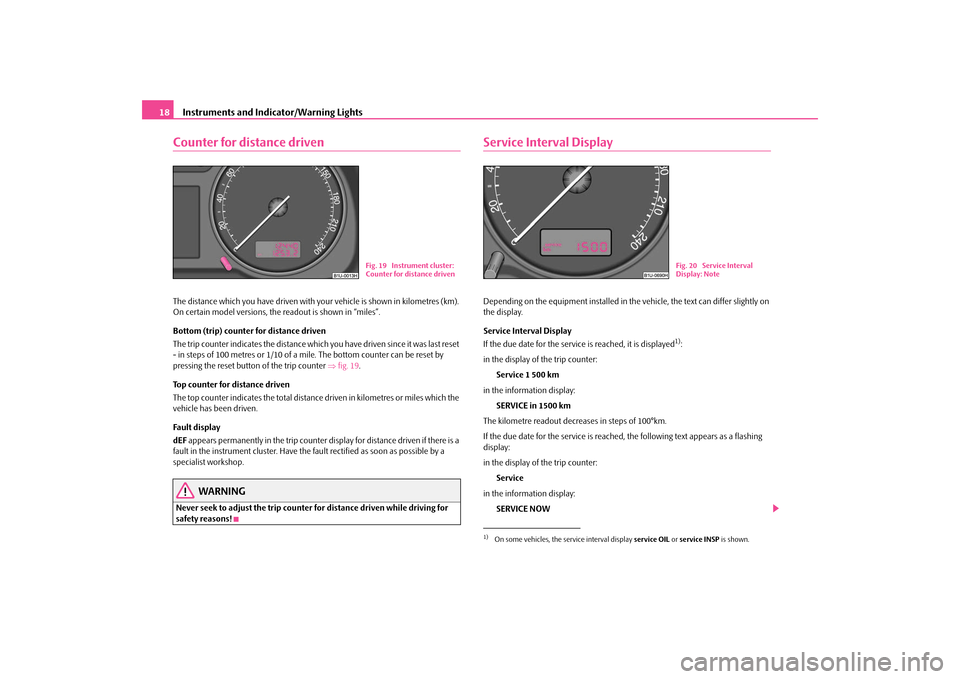
Instruments and Indicator/Warning Lights
18
Counter for distance drivenThe distance which you have driven with yo
ur vehicle is shown
in kilometres (km).
On certain model versions, the
readout is shown in “miles”.
Bottom (trip) counter for distance driven The trip counter indicates the distance which you have driven since it was last reset - in steps of 100 metres or 1/10 of a mile. The bottom counter can be reset by pressing the reset button of the trip counter
⇒fig. 19
.
Top counter for distance driven The top counter indicates the total distance driven in kilometres or miles which the vehicle has been driven. Fa ult di spl ay dEF
appears permanently in the trip counter display for distance driven if there is a
fault in the instrument cluste
r. Have the fault rectified
as soon as possible by a
specialist workshop.
WARNING
Never seek to adjust the trip counter
for distance driven while driving for
safety reasons!
Service Interval DisplayDepending on the equipment installed in the vehicle, the text can differ slightly on the display. Service Interval Display If the due date for the service is reached, it is displayed
1):
in the display of the trip counter:
Service 1 500 km
in the information display:
SERVICE in 1500 km
The kilometre readout decreases in steps of 100°km.If the due date for the service is reached,
the following text appears as a flashing
display: in the display of the trip counter:
Service
in the information display:
SERVICE NOW
Fig. 19 Instrument cluster: Counter for distance driven
1)On some vehicles, the service interval display
service OIL
or service INSP
is shown.
Fig. 20 Service Interval Display: Note
s2g8.b.book Page 18 Tuesday, April 7, 2009 8:53 AM
Page 20 of 224
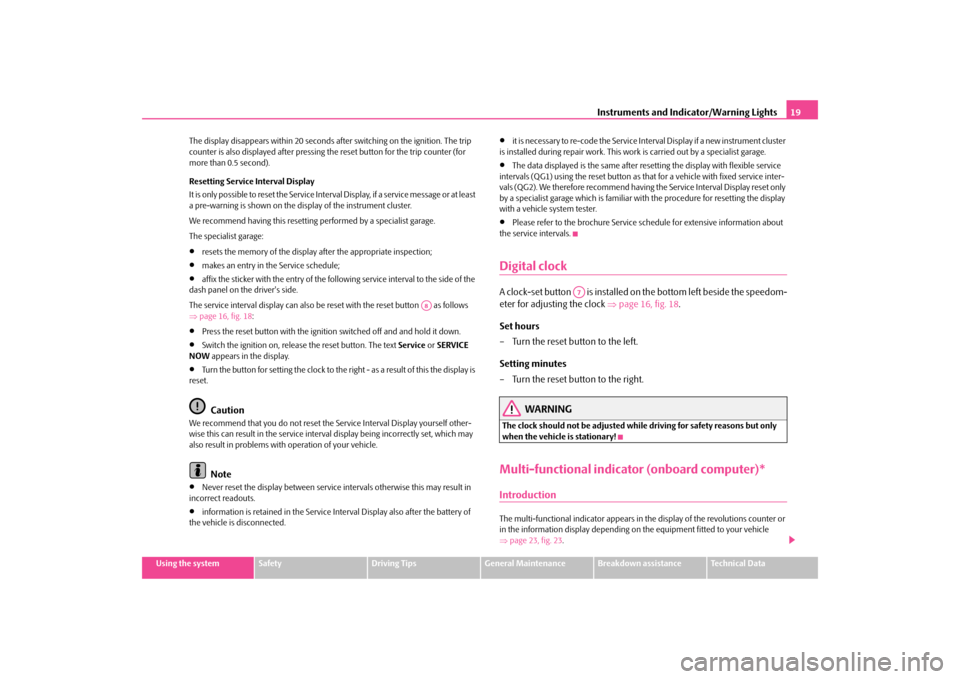
Instruments and Indicator/Warning Lights
19
Using the system
Safety
Driving Tips
General Maintenance
Breakdown assistance
Technical Data
The display disappears within 20 seconds after switching on the ignition. The trip counter is also displayed af
ter pressing the reset button for the trip counter (for
more than 0.5 second). Resetting Service Interval Display It is only possible to reset the Service Interval Display, if a service message or at least a pre-warning is shown on the display of the instrument cluster. We recommend having this
resetting performed by a specialist garage.
The specialist garage:•
resets the memory of the display after the appropriate inspection;
•
makes an entry in the Service schedule;
•
affix the sticker with the entry of the following service interval to the side of the
dash panel on the driver's side. The service interval display can also be reset with the reset button as follows ⇒ page 16, fig. 18
:
•
Press the reset button with the ignition switched off and and hold it down.
•
Switch the ignition on, release the reset button. The text
Service
or SERVICE
NOW
appears in the display.
•
Turn the button for setting the clock to the right - as a result of this the display is
reset.
Caution
We recommend that you do not reset the
Service Interval Disp
lay yourself other-
wise this can result in the service interval display being incorrectly set, which may also result in problems with operation of your vehicle.
Note
•
Never reset the display between service intervals otherwise this may result in
incorrect readouts.•
information is retained in the Service Interval Display also after the battery of
the vehicle is disconnected.
•
it is necessary to re-code the Service Interval Display if a new instrument cluster
is installed during repair work. This work
is carried out by a specialist garage.
•
The data displayed is the same after rese
tting the display with flexible service
intervals (QG1) using the reset button as th
at for a vehicle with fixed service inter-
vals (QG2). We therefore recommend having the Service Interval Display reset only by a specialist garage which is familiar with the procedure for resetting the display with a vehicle system tester.•
Please refer to the brochure Service schedule for extensive information about
the service intervals.Digital clockA clock-set button is installed on the bottom left beside the speedom- eter for adjusting the clock
⇒
page 16, fig. 18
.
Set hours – Turn the reset button to the left. Setting minutes – Turn the reset button to the right.
WARNING
The clock should not be adjusted while driving for safety reasons but only when the vehicle is stationary!Multi-functional indicator (onboard computer)*IntroductionThe multi-functional indicator appears in
the display of the revolutions counter or
in the information display depending on
the equipment fitte
d to your vehicle
⇒ page 23, fig. 23
.
A8
A7
s2g8.b.book Page 19 Tuesday, April 7, 2009 8:53 AM
Page 24 of 224
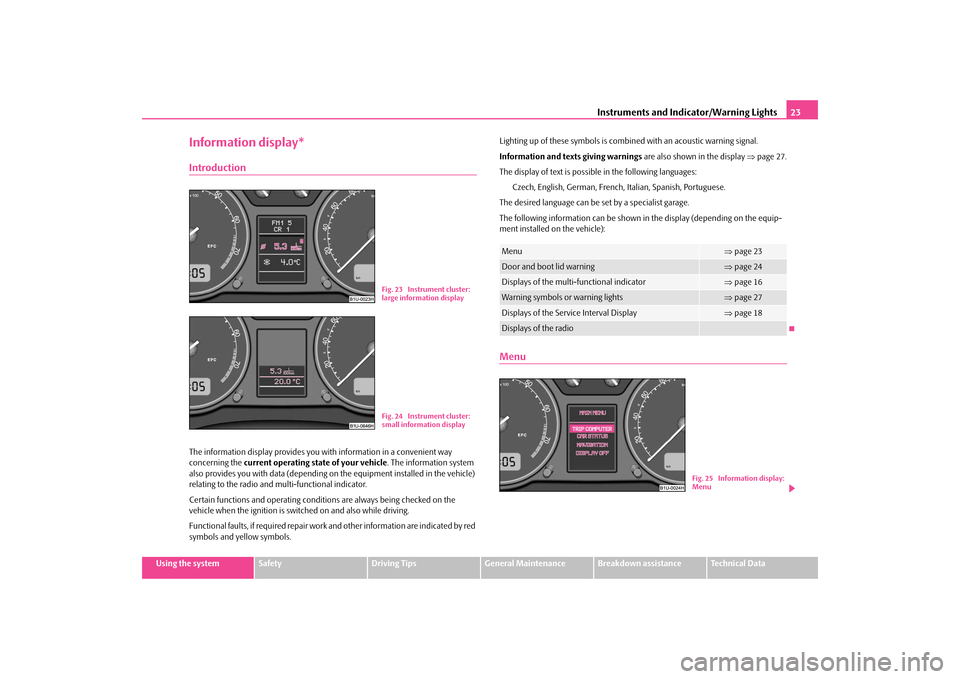
Instruments and Indicator/Warning Lights
23
Using the system
Safety
Driving Tips
General Maintenance
Breakdown assistance
Technical Data
Information display*IntroductionThe information display provides you with information in a convenient way concerning the
current operating state of your vehicle
. The information system
also provides you with data (depending on the equipment installed in the vehicle) relating to the radio and multi-functional indicator. Certain functions and oper
ating conditions are always being checked on the
vehicle when the ignition is switched on and also while driving. Functional faults, if required
repair work and other information are indicated by red
symbols and yellow symbols.
Lighting up of these symbols is combined with an acoustic warning signal. Information and texts giving warnings
are also shown in the display
⇒page 27.
The display of text is possible in the following languages:
Czech, English, German, French,
Italian, Spanish, Portuguese.
The desired language can be
set by a specialist garage.
The following information can be shown in
the display (depending on the equip-
ment installed on the vehicle):Menu
Fig. 23 Instrument cluster: large information displayFig. 24 Instrument cluster: small information display
Menu
⇒ page 23
Door and boot lid warning
⇒page 24
Displays of the multi-functional indicator
⇒page 16
Warning symbols or warning lights
⇒page 27
Displays of the Service Interval Display
⇒page 18
Displays of the radio
Fig. 25 Information display: Menu
s2g8.b.book Page 23 Tuesday, April 7, 2009 8:53 AM
Page 26 of 224
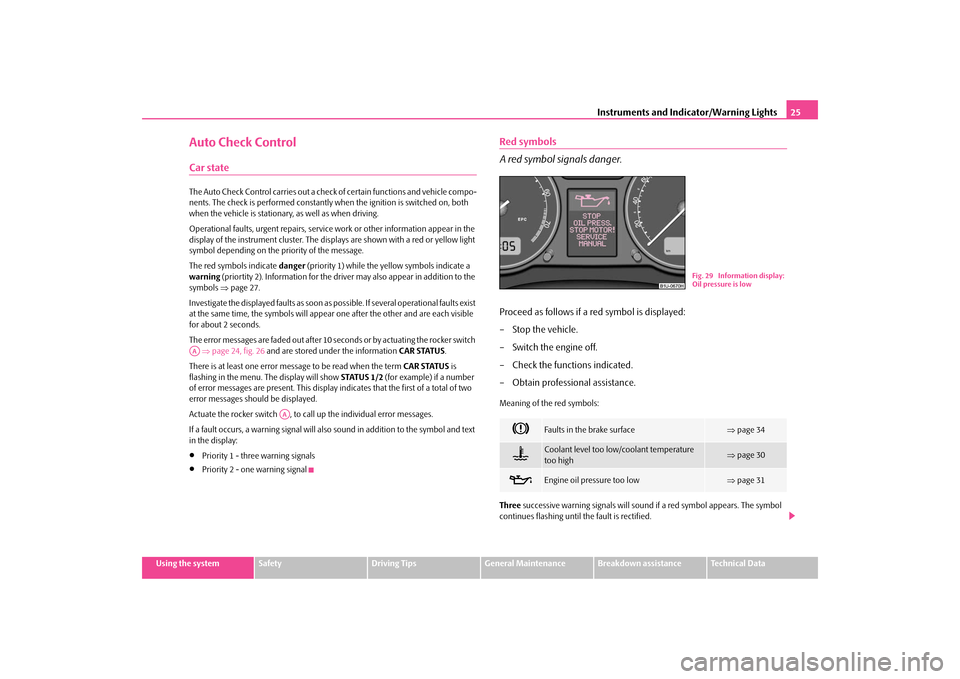
Instruments and Indicator/Warning Lights
25
Using the system
Safety
Driving Tips
General Maintenance
Breakdown assistance
Technical Data
Auto Check ControlCar stateThe Auto Check Control carries out a check of certain functions and vehicle compo- nents. The check is performed constantly
when the ignition is switched on, both
when the vehicle is stationary, as well as when driving. Operational faults, urgent repairs, service
work or other information appear in the
display of the instrument cluster. The disp
lays are shown with a red or yellow light
symbol depending on the priority of the message. The red symbols indicate
danger
(priority 1) while the yellow symbols indicate a
warning
(priortity 2). Information for the driver
may also appear in addition to the
symbols
⇒page 27.
Investigate the displayed faults as soon as
possible. If several operational faults exist
at the same time, the symbols will appear
one after the other and are each visible
for about 2 seconds. The error messages are faded out after 10 seconds or by actuating the rocker switch ⇒page 24, fig. 26
and are stored under the information
CAR STATUS
.
There is at least one error message to be read when the term
CAR STATUS
is
flashing in the menu. The display will show
STATUS 1/2
(for example) if a number
of error messages are present. This display
indicates that the first of a total of two
error messages should be displayed. Actuate the rocker switch , to call up the individual error messages.If a fault occurs, a warning signal will also sound in addition to the symbol and text in the display:•
Priority 1 - three warning signals
•
Priority 2 - one warning signal
Red symbols A red symbol signals danger.Proceed as follows if a red symbol is displayed: – Stop the vehicle.– Switch the engine off. – Check the functions indicated. – Obtain professional assistance.Meaning of the red symbols: Three
successive warning signals will sound if a red symbol appears. The symbol
continues flashing until
the fault is rectified.
AA
AA
Faults in the brake surface
⇒page 34
Coolant level too low/coolant temperature too high
⇒ page 30
Engine oil pressure too low
⇒page 31
Fig. 29 Information display: Oil pressure is low
s2g8.b.book Page 25 Tuesday, April 7, 2009 8:53 AM
Page 32 of 224
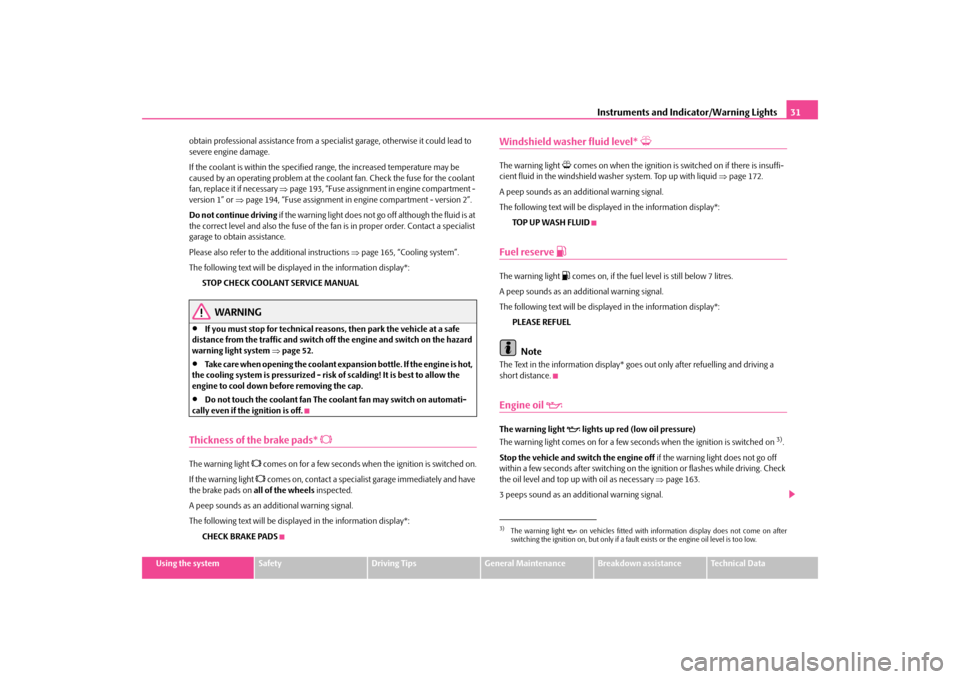
Instruments and Indicator/Warning Lights
31
Using the system
Safety
Driving Tips
General Maintenance
Breakdown assistance
Technical Data
obtain professional assistance from a specialist garage, otherwise it could lead to severe engine damage. If the coolant is within the specified
range, the increased temperature may be
caused by an operating problem at the coolant fan. Check the fuse for the coolant fan, replace it if necessary
⇒page 193, “Fuse assignment in engine compartment -
version 1” or
⇒page 194, “Fuse assignment in en
gine compartment - version 2”.
Do not continue driving
if the warning light does not go
off although the fluid is at
the correct level and also the fuse of the fa
n is in proper order. Contact a specialist
garage to obtain assistance. Please also refer to the additional instructions
⇒page 165, “Cooling system”.
The following text will be displayed in the information display*:
STOP CHECK COOLANT SERVICE MANUAL
WARNING
•
If you must stop for technical reasons, then park the vehicle at a safe
distance from the traffic
and switch off the engine and switch on the hazard
warning light system
⇒page 52.
•
Take care when opening the coolant expa
nsion bottle. If the engine is hot,
the cooling system is pressurized - risk of scalding! It is best to allow the engine to cool down before removing the cap.•
Do not touch the coolant fan The coolant fan may switch on automati-
cally even if the ignition is off.Thickness of the brake pads*
The warning light
comes on for a few seconds when the ignition is switched on.
If the warning light
comes on, contact a specialist garage immediately and have
the brake pads on
all of the wheels
inspected.
A peep sounds as an addi
tional warning signal.
The following text will be displayed in the information display*:
CHECK BRAKE PADS
Windshield washer fluid level*
The warning light
comes on when the ignition is
switched on if there is insuffi-
cient fluid in the windshield washer system. Top up with liquid
⇒page 172.
A peep sounds as an additional warning signal.The following text will be displayed in the information display*:
TOP UP WASH FLUID
Fuel reserve
The warning light
comes on, if the fuel level is still below 7 litres.
A peep sounds as an additional warning signal.The following text will be displayed in the information display*:
PLEASE REFUELNote
The Text in the information display* goes out only after refuelling and driving a short distance.Engine oil
The warning light
lights up red (low oil pressure)
The warning light comes on for a few seconds when the ignition is switched on
3).
Stop the vehicle and sw
itch the engine off
if the warning light does not go off
within a few seconds after switching on the ignition or flashes while driving. Check the oil level and top up with oil as necessary
⇒page 163.
3 peeps sound as an additional warning signal.3)The warning light
on vehicles fitted with information display does not come on after
switching the ignition on, but only if a fault exists or the engine oil level is too low.
s2g8.b.book Page 31 Tuesday, April 7, 2009 8:53 AM
Page 33 of 224
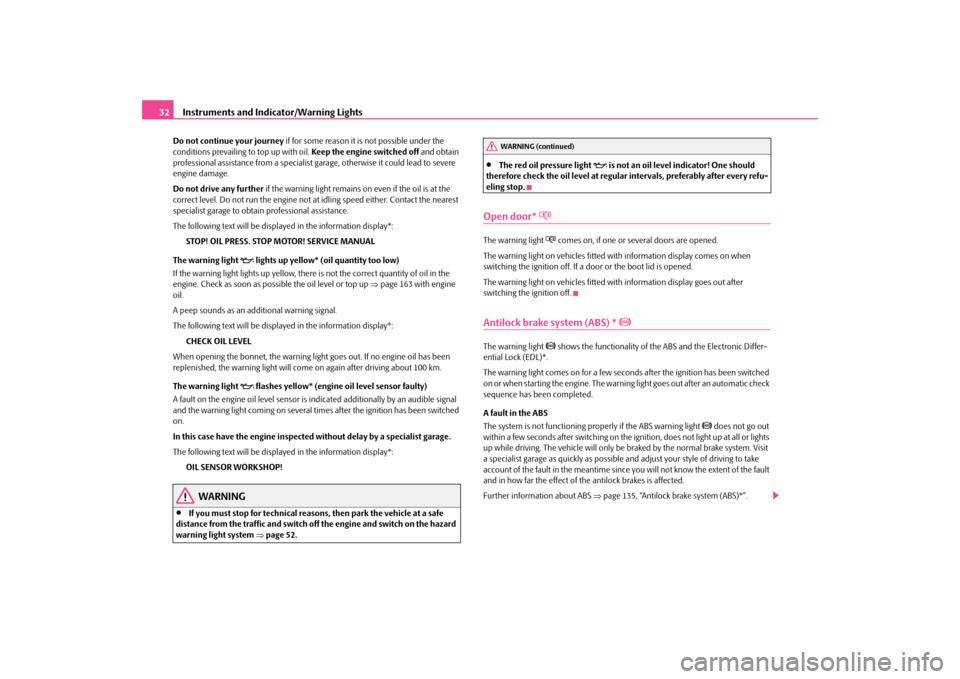
Instruments and Indicator/Warning Lights
32
Do not continue your journey
if for some reason it is not possible under the
conditions prevailing
to top up with oil.
Keep the engine switched off
and obtain
professional assistance from a specialist garage, otherwise it could lead to severe engine damage. Do not drive any further
if the warning light remains on even if the oil is at the
correct level. Do not run the engine not at
idling speed either. Contact the nearest
specialist garage to obtain professional assistance. The following text will be displayed in the information display*:
STOP! OIL PRESS. STOP MOTOR! SERVICE MANUAL
The warning light
lights up yellow* (oil quantity too low)
If the warning light lights up yellow, there is not the correct quantity of oil in the engine. Check as soon as possible the oil level or top up
⇒page 163 with engine
oil. A peep sounds as an additional warning signal.The following text will be displayed in the information display*:
CHECK OIL LEVEL
When opening the bonnet, the warning light
goes out. If no engine oil has been
replenished, the warning light will come on again after driving about 100 km. The warning light
flashes yellow* (engine oil level sensor faulty)
A fault on the engine oil level sensor is in
dicated additionally by
an audible signal
and the warning light coming on several times after the ignition has been switched on. In this case have the engine inspecte
d without delay by a specialist garage.
The following text will be displayed in the information display*:
OIL SENSOR WORKSHOP!
WARNING
•
If you must stop for technical reasons, then park the vehicle at a safe
distance from the traffic and switch off the engine and switch on the hazard warning light system
⇒page 52.
•
The red oil pressure light
is not an oil level indicator! One should
therefore check the oil level at regular
intervals, preferably after every refu-
eling stop.Open door*
The warning light
comes on, if one or several doors are opened.
The warning light on vehicles fitted with information display comes on when switching the ignition off. If a door or the boot lid is opened. The warning light on vehicles fitted with information display goes out after switching the ignition off.Antilock brake system (ABS) *
The warning light
shows the functionality of the ABS and the Electronic Differ-
ential Lock (EDL)*. The warning light comes on for a few seconds after the ignition has been switched on or when starting the engine. The warnin
g light goes out after an automatic check
sequence has been completed. A fault in the ABS The system is not functioning properly if the ABS warning light
does not go out
within a few seconds after switching on the ig
nition, does not light up at all or lights
up while driving. The vehicle
will only be braked by th
e normal brake system. Visit
a specialist garage as quickly as possible and adjust your style of driving to take account of the fault in the meantime since
you will not know the extent of the fault
and in how far the effect of the antilock brakes is affected. Further information about ABS
⇒page 135, “Antilock brake system (ABS)*”.
WARNING (continued)
s2g8.b.book Page 32 Tuesday, April 7, 2009 8:53 AM
Page 35 of 224
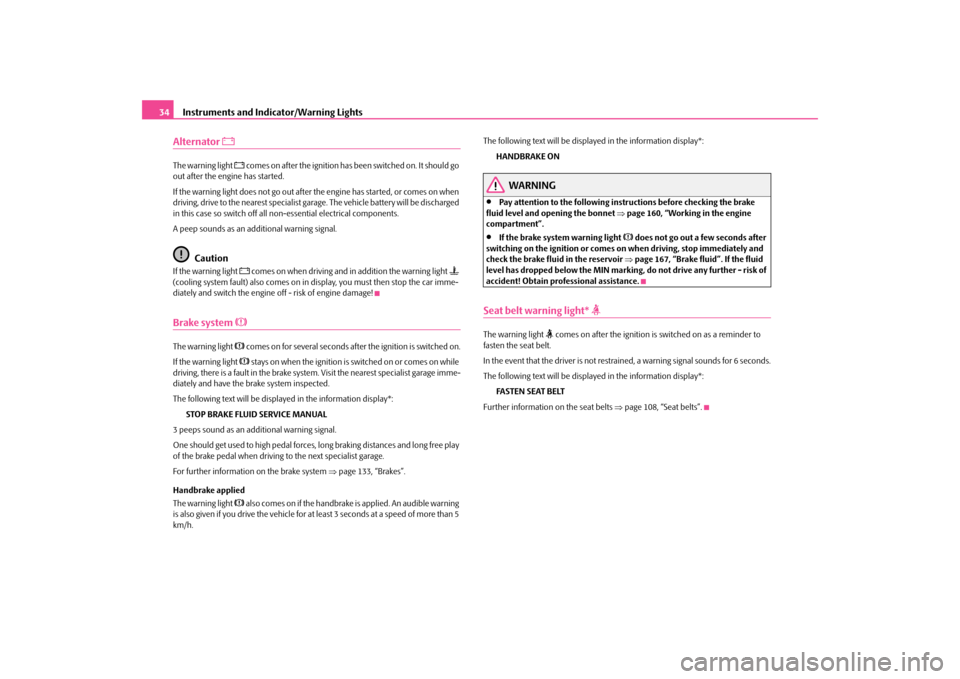
Instruments and Indicator/Warning Lights
34
Alternator
The warning light
comes on after the ignition has been switched on. It should go
out after the engine has started. If the warning light does not go out after the engine has started, or comes on when driving, drive to the nearest specialist garage. The vehicle battery will be discharged in this case so switch off all non-essential electrical components. A peep sounds as an additional warning signal.
Caution
If the warning light
comes on when driving and in addition the warning light
(cooling system fault) also comes on in display, you must then stop the car imme- diately and switch the engine
off - risk of engine damage!
Brake system
The warning light
comes on for several seconds after the ignition is switched on.
If the warning light
stays on when the ignition is switched on or comes on while
driving, there is a fault in the brake system. Visit the nearest specialist garage imme-diately and have the brake system inspected. The following text will be displayed in the information display*:
STOP BRAKE FLUID SERVICE MANUAL
3 peeps sound as an additional warning signal.One should get used to high pedal forces, long braking distances and long free play of the brake pedal when driving to the next specialist garage. For further information on the brake system
⇒page 133, “Brakes”.
Handbrake applied The warning light
also comes on if the handbrake is applied. An audible warning
is also given if you drive the vehicle for at least 3 seconds at a speed of more than 5 km/h.
The following text will be displayed in the information display*:
HANDBRAKE ON
WARNING
•
Pay attention to the following instru
ctions before checking the brake
fluid level and opening the bonnet
⇒page 160, “Working in the engine
compartment”.•
If the brake system warning light
does not go out a few seconds after
switching on the ignition or comes on when driving, stop immediately and check the brake fluid in the reservoir
⇒page 167, “Brake fluid”. If the fluid
level has dropped below the MIN marking,
do not drive any further - risk of
accident! Obtain prof
essional assistance.
Seat belt warning light*
The warning light
comes on after the ignition is
switched on as a reminder to
fasten the seat belt. In the event that the driver is not restrained, a warning signal sounds for 6 seconds.The following text will be displayed in the information display*:
FASTEN SEAT BELT
Further information on the seat belts
⇒page 108, “Seat belts”.
s2g8.b.book Page 34 Tuesday, April 7, 2009 8:53 AM
Page 165 of 224
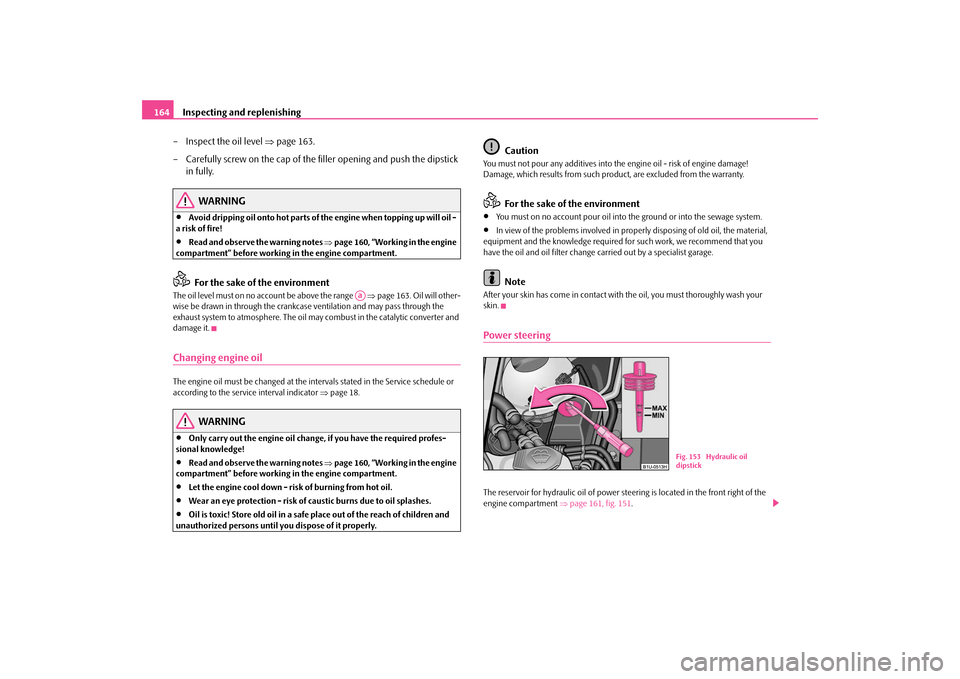
Inspecting and replenishing
164
– Inspect the oil level
⇒
page 163.
– Carefully screw on the cap of the
filler opening and push the dipstick
in fully.
WARNING
•
Avoid dripping oil onto hot parts of the engine when topping up will oil -
a risk of fire!•
Read and observe the warning notes
⇒page 160, “Working in the engine
compartment” before working in the engine compartment.
For the sake of the environment
The oil level must on no account be above the range
⇒page 163. Oil will other-
wise be drawn in through the crankcas
e ventilation and may pass through the
exhaust system to atmosphere. The oil ma
y combust in the cata
lytic converter and
damage it.Changing engine oilThe engine oil must be changed at the intervals stated in the Service schedule or according to the service interval indicator
⇒page 18.
WARNING
•
Only carry out the engine oil change, if you have the required profes-
sional knowledge!•
Read and observe the warning notes
⇒page 160, “Working in the engine
compartment” before working in the engine compartment.•
Let the engine cool down - risk of burning from hot oil.
•
Wear an eye protection - risk of
caustic burns due to oil splashes.
•
Oil is toxic! Store old oil in a safe place out of the reach of children and
unauthorized persons until you dispose of it properly.
Caution
You must not pour any additives into th
e engine oil - risk of engine damage!
Damage, which results from such produc
t, are excluded from the warranty.
For the sake of the environment
•
You must on no account pour oil into
the ground or into the sewage system.
•
In view of the problems involved in prop
erly disposing of old oil, the material,
equipment and the knowledge required fo
r such work, we recommend that you
have the oil and oil filter change carried out by a specialist garage.
Note
After your skin has come in contact with the oil, you must thoroughly wash your skin.Power steeringThe reservoir for hydraulic oil of power stee
ring is located in the front right of the
engine compartment
⇒page 161, fig. 151
.
Aa
Fig. 153 Hydraulic oil dipstick
s2g8.b.book Page 164 Tuesday, April 7, 2009 8:53 AM